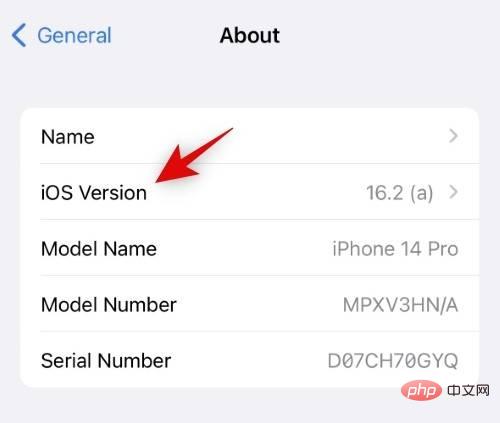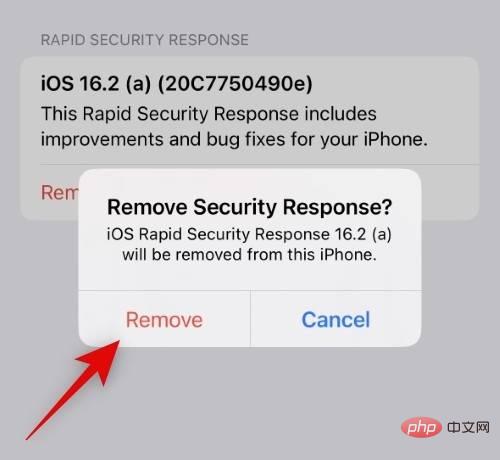How to uninstall iPhone security updates and find out why?
Apple is now slightly changing the way it updates iPhones and iPads by separating security updates from feature updates by releasing iOS 16 and iPadOS 16.1 separately. It appears to be a leaf in Microsoft's book that selective security response updates will help Apple ensure maximum security and stability of its devices without having to wait weeks for the release of upcoming features. However, as with every operating system update for any device, you may encounter bugs and issues that can hinder your workflow. Thankfully, like Windows, Apple allows you to uninstall security updates—called Rapid Security Response—if needed. Let’s find out how to remove and why or if you should uninstall them.
How to uninstall security updates (Rapid Security Responses) on iPhone
Before you can uninstall Rapid Security Responses from iPhone, you need to meet some requirements. Use the sections below to familiarize yourself with them.
Requires
- iOs 16.2 or later
As of this writing, iOS 16.2 is still in beta. If you'd like, you can sign up for Apple's beta program to get immediate access to this feature. However, let's say you plan to use the beta version in your daily driver. We don't recommend this in this case, as beta iOS builds often contain bugs that can cause instability in everyday drivers. In this case, we recommend you wait a few weeks for the public release of iOS 16.2.
Step-by-Step Tutorial
Here’s how to uninstall Rapid Security Responses from iPhone.
Open the Settings app and tap General.

Now click and select About.

Click and select iOS Version under Name.

#You will now see a list of installed security updates under Rapid Security Response. Find the relevant update you want to uninstall and click Remove Security Response.

Click Delete to confirm your choice.

When prompted, enter your iPhone’s passcode.

#You can now track the deletion process in real time with relevant updates. Once completed, your iPhone will restart and delete the selected Quick Security Response. Do not interrupt this process as it may take a few seconds for your iPhone to turn back on on its own.

#This is how you remove Quick Security Response from iPhone.
Why and when to uninstall Rapid Security Responses on your iPhone?
There are not many reasons to remove Rapid Security Responses from your iPhone. These updates are designed to patch exploits, bugs, and other security flaws that could put your iPhone at risk. But in some cases, if a newer update ends up introducing issues and bugs, then you may choose to temporarily uninstall the update until Apple releases a new update.
On the other hand, if you are a security researcher, application developer, or an avid jailbreaker, security response updates may hinder your workflow. In this case, you can also choose to remove Quick Security Response from iPhone.
The above is the detailed content of How to uninstall iPhone security updates and find out why?. For more information, please follow other related articles on the PHP Chinese website!

Hot AI Tools

Undresser.AI Undress
AI-powered app for creating realistic nude photos

AI Clothes Remover
Online AI tool for removing clothes from photos.

Undress AI Tool
Undress images for free

Clothoff.io
AI clothes remover

Video Face Swap
Swap faces in any video effortlessly with our completely free AI face swap tool!

Hot Article

Hot Tools

Notepad++7.3.1
Easy-to-use and free code editor

SublimeText3 Chinese version
Chinese version, very easy to use

Zend Studio 13.0.1
Powerful PHP integrated development environment

Dreamweaver CS6
Visual web development tools

SublimeText3 Mac version
God-level code editing software (SublimeText3)

Hot Topics
 iPhone 16 Pro and iPhone 16 Pro Max official with new cameras, A18 Pro SoC and larger screens
Sep 10, 2024 am 06:50 AM
iPhone 16 Pro and iPhone 16 Pro Max official with new cameras, A18 Pro SoC and larger screens
Sep 10, 2024 am 06:50 AM
Apple has finally lifted the covers off its new high-end iPhone models. The iPhone 16 Pro and iPhone 16 Pro Max now come with larger screens compared to their last-gen counterparts (6.3-in on the Pro, 6.9-in on Pro Max). They get an enhanced Apple A1
 iPhone parts Activation Lock spotted in iOS 18 RC — may be Apple\'s latest blow to right to repair sold under the guise of user protection
Sep 14, 2024 am 06:29 AM
iPhone parts Activation Lock spotted in iOS 18 RC — may be Apple\'s latest blow to right to repair sold under the guise of user protection
Sep 14, 2024 am 06:29 AM
Earlier this year, Apple announced that it would be expanding its Activation Lock feature to iPhone components. This effectively links individual iPhone components, like the battery, display, FaceID assembly, and camera hardware to an iCloud account,
 iPhone parts Activation Lock may be Apple\'s latest blow to right to repair sold under the guise of user protection
Sep 13, 2024 pm 06:17 PM
iPhone parts Activation Lock may be Apple\'s latest blow to right to repair sold under the guise of user protection
Sep 13, 2024 pm 06:17 PM
Earlier this year, Apple announced that it would be expanding its Activation Lock feature to iPhone components. This effectively links individual iPhone components, like the battery, display, FaceID assembly, and camera hardware to an iCloud account,
 Multiple iPhone 16 Pro users report touchscreen freezing issues, possibly linked to palm rejection sensitivity
Sep 23, 2024 pm 06:18 PM
Multiple iPhone 16 Pro users report touchscreen freezing issues, possibly linked to palm rejection sensitivity
Sep 23, 2024 pm 06:18 PM
If you've already gotten your hands on a device from the Apple's iPhone 16 lineup — more specifically, the 16 Pro/Pro Max — chances are you've recently faced some kind of issue with the touchscreen. The silver lining is that you're not alone—reports
 Gate.io trading platform official app download and installation address
Feb 13, 2025 pm 07:33 PM
Gate.io trading platform official app download and installation address
Feb 13, 2025 pm 07:33 PM
This article details the steps to register and download the latest app on the official website of Gate.io. First, the registration process is introduced, including filling in the registration information, verifying the email/mobile phone number, and completing the registration. Secondly, it explains how to download the Gate.io App on iOS devices and Android devices. Finally, security tips are emphasized, such as verifying the authenticity of the official website, enabling two-step verification, and being alert to phishing risks to ensure the safety of user accounts and assets.
 Beats adds phone cases to its lineup: unveils a MagSafe case for the iPhone 16 series
Sep 11, 2024 pm 03:33 PM
Beats adds phone cases to its lineup: unveils a MagSafe case for the iPhone 16 series
Sep 11, 2024 pm 03:33 PM
Beats is known for launching audio products such as Bluetooth speakers and headphones, but in what can best be described as a surprise, the Apple-owned company has branched into making phone cases, starting with the iPhone 16 series. The Beats iPhone
 How to solve the problem of 'Undefined array key 'sign'' error when calling Alipay EasySDK using PHP?
Mar 31, 2025 pm 11:51 PM
How to solve the problem of 'Undefined array key 'sign'' error when calling Alipay EasySDK using PHP?
Mar 31, 2025 pm 11:51 PM
Problem Description When calling Alipay EasySDK using PHP, after filling in the parameters according to the official code, an error message was reported during operation: "Undefined...
 Anbi app official download v2.96.2 latest version installation Anbi official Android version
Mar 04, 2025 pm 01:06 PM
Anbi app official download v2.96.2 latest version installation Anbi official Android version
Mar 04, 2025 pm 01:06 PM
Binance App official installation steps: Android needs to visit the official website to find the download link, choose the Android version to download and install; iOS search for "Binance" on the App Store. All should pay attention to the agreement through official channels.





